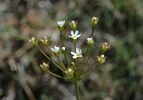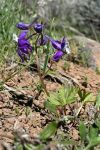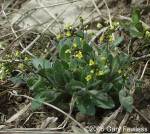May flowers seen in GVM, please email us your sightings.

5/31/09 Jim emailed: “spotted another even more diminutive annual called, appropriately, Blue-eyed Mary or Hunchback Flower (Collinsia parviflora). I knew it from some work I did as the taxonomist on a multi-agency, post-fire study a few summers back at the Sheldon National Wildlife Area in the northwestern corner of NV. Only one species in the genus, parviflora means small-flowered; but a beautiful one it is. Weber & Wittmann write: “Very common but inconspicuous and delicate annual, blossoming very early at low altitudes. . . . Leaves usually strongly purplish-tinged. The hump-backed corolla is distinctive.”

5/31/09 Jim emailed: Madwort (Asperugo procumbens). I spotted this amongst other weeds as I was climbing my stairs to the house; the tiny purple flowers catching my eye. My immediate thought was a borage. From Weber & Whitman: “The name borage comes from a Middle Latin source, burra, meaning rough hair or wool, just as the modern word, bur.” One of the few exceptions to having very stiff hairs on the stems and leaves, our bluebells (Mertensia lanceolata) now in full bloom. As for this madwort, Weber & Whitman state: “Alien on disturbed ground at the base of the Front Range. The enlarged and flat-open calyx becomes conspicuous after the flowers wither, and it is provided with hooked bristles. An unmistakable plant.”

5/27/09 Ellen sent: Tufted Evening Primrose (Oenothera caespitosa). We have three plants blooming our “back yard.”

5/15/09 Rock-jasmine (Androsace septentrionale), in the Primrose Family (Primulaceae). “Forested or open sites (except desert), from foothills to alpine tundra, extremely variable.” A common early bloomer down in the foothills of the San Luis Valley where I lived, I recognized it when out walking in the nearby meadow this afternoon (May 15).

5/15/09 False Arabis; Rockcress (Boechera [Arabis] fendleri) Weber & Wittmann: “Common, outer foothills of Front Range.” Only two species of Boechera are common to this area, the other B. drummondii. Weber & Wittmann continue: “In early spring, the new vegetative shoots are affected by a rust fungus, Puccinia monoica, which produces an aecial stage of yellow-orange pustules that cover the upper leaves. Every spring someone brings his in to ask what kind of wildflower it might be.” I found just such an oddity just this morning, May 15, after I’d spotted the plant in flower elsewhere and recognized it as a rockcress. Below, the Boulder Camera article’s recent date, February of this year (found in Google). http://www.dailycamera.com/news/2009/feb/26/march-nature-almanac/?partner%253DRSS

5/13 Jim Erdman: “Today I finally saw the larkspur (Delphinium nuttallianum) with only one deep purple bloom; I’d been puzzled earlier this spring by the deeply cut compound leaves.

- Sandlily
5/13/09 Ellen Heath: I have 100’s of Sand Lilies (Leucocrinum montanum, Liliaceae) on the sunny, dry parts of our property. Photo taken at 2:19 this afternoon. From Beidleman, Beidleman & Willard, Plants of Rocky Mountain National Park: “Sandlily has no stems so its white flowers are situated in the center of a basal cluster of long narrow leaves.” From Jim Erdman 5/13: Journal entry for Sunday May 4th of last year (2008). “[This] afternoon hike alone on Pawnee National Grassland — dry as a bone! Sand lily only flowering plant & common — deep roots. Looked like someone threw golf balls around. ”

5/11/09 Jim Erdman: Early afternoon during my wandering through the meadow nearby the USFS’s inholding spotted what appeared to be a Heuchera in the Saxifrage Family. A reasonably small family of some dozen genera, it keyed out easily to Saxifrage (Micrantha [Saxifraga] rhomboidea). In fact, Weber & Wittmann have it illustrated in a figure (the one below, from my Googling, but under the genus, Saxifraga). Of the several species of Micrantha here on the Eastern Slope, the description for this species:”. . . plants on rocky slopes moist in spring, open ground, not wet meadows or streamsides. Common from the outer foothills to the alpine tundra.” Just starting to flower, it’s quite abundant in parts of the meadow. I note that it IS in the provisional plant list, as is Alum-root (Heuchera parvifolia). Both of these were added after the initial list of 8/12/08 with only ~108 species. As of Ellen’s update yesterday, ~231 species.


5/6/09 Jim Erdman: Woodland Draba (Draba nemorosa) an annual alien (i.e., weed) in disturbed areas
Discover more from Glacier View Meadows Ecology
Subscribe to get the latest posts to your email.
Delphinium geyeri blooms in early spring and is rather diminuitive. nuttalianum is a late summer bloomer and pretty robust.
Sure that’s not Delphinium geyeri? It’s a common early bloomer, with a long thin flower stem and few to several, deep purple flowers. The basal leaves form a small cluster about 6″ around. D. nuttallianum blooms in later summer and has many paler (white to lavender) flowers crowded on a 4 to 10″ raceme. It is a robust plant, up to 18″ tall and nearly as wide and is common in the waste areas along the roadsides. (Description is from memory, not the flora). Plant list is looking good, keep up the great work Jim! Need to add Pinus flexilis. I just pulled a specimen off the little one on the neighbors lot. 5 needles per fascicle. Keep an eye out for Escobaria vivipara var. vivipara around here too. This cactus looks about the same as P. simpsonii, but the flowers emerge from the tubercle tips, versus between them (or was it the other way around?) lol
Great job on the Blog Ellen! I hope I can help out more this year! Off to botanize in the Utah desert for most of June though, then up to Guersey Wy, for a wetland delineation project!
Thanks for the Saxifrage rhomboidea Jim. i was wondering what that basal rosette of leaves was going to be, now i know! I’ve noticed a little Scroph is getting ready to bloom here under the pines. Has a cylindric raceme, packed with yellow flowers. About 6″ tall. Looks a lttle like a besseya or collinsia. Funny, I do this for a living, but I don’t know everything that’s growing in my own yard! Not enough hours in the day sometimes. Also, a lot of sedges to work on. Likely suspects are Carex nebraskensis, C. stenophylla, C. rossii, C. rostrata, maybe C. filifolia and probably others. I can see this plant list hitting 350 soon! Wait, is that possible around here? We need to get our own herbarium going someday. Thanks to all that have worked on this plant list, it’s a great resource!!!
Paul, I realize you’re off in the wilds out West, but here’s my reply re the two species of larkspur. Weber & Wittmann describe the two, thusly; what I think, still, is nuttallianum, key 2a, “Roots fusiform, clustered [which I’ve yet to study]; flowers deep blue-purple; leaves with many deep narrow lobes. Meadows, sagebrush, open woods; very common in early spring.” And this for key 2b: “Roots elongate, fibrous; flowers light blue or white.” Which leads to your geyeri: “Stems densely clustered, becoming a very bushy clump; flowers bright blue. Common on the outwash mesas at the base of the Front Range and northeastward in the South Platte drainage.”
Ours are definitely deep purple and definitely not robust. Generally ~6″ tall; at most, 8″, as just measured outside at sundown. Not “up to 18″ tall and nearly as wide.”
Keep up the good dialog!
Your right Jim ! Instead of praddling on, from what I thought was a correct memory, I just keyed one out. And so, that got me thinking about the bushy roadside plant that blooms late summer and was describing as D. nuttalianum. Then it came to me. Lupinus… I think aregenteus….but you better check! Oh, well, open mouth insert foot.
Heading to somewhat remote SW Utah on Monday. Propane fridge and a few hours of generator power a day at an old research purpose built cabin at the Desert Experimental Range. Fortunately, my field partner is a dedicated taxonomist. lol Keep up the great work!